That contemporary art in China has developed in response to the cultural, political, intellectual, economic, and social conditions of its particular (and highly transformative) environment is beyond doubt. Yet to what extent we view art as merely reflective, illustrative, or representative of its specific cultural context, rather than endowed with the capacity to transcend difference and engage critically to change, readapt, redesign, or push against these contested frameworks, has nearly always been in question. It is this contradiction—between art’s capacity to reveal certain social determinants and its ability or willingness to effect change upon them—that underlies much of contemporary art production today. The tendency to go against prescribed systems and institutional structures in the art world, cross the boundaries of art, or question how we define art in the first place, has become accepted shorthand for closing the gap between art and everyday life, itself a gesture widely interpreted as promoting positive values and contributing to the betterment of society at large. How such transgressions might come to be envisioned, realized, and recognized, in a place like contemporary China—with its underdeveloped art infrastructure and overdeveloped sense of control—still remains to be seen.
China finds itself today in a peculiar position vis-à-vis the global art world. While international art centers struggle to define the role of art institutions, and countless artists and curators appear eager to jettison their modernist frameworks and container aesthetics, China is eagerly adopting the very institutional systems and structures that the Western art world is ready to abandon. The overarching narrative of contemporary art in China, starting with the late 1970s, has been largely predicated on acknowledgement, acceptance, and recognition by the “official” system, even as Chinese artists struggled with its ideologies and prescribed stylistic conventions. The debates and discussions which followed centered on the exclusion of certain art forms from the official ranks, without calling into question the inequalities and injustices of the system itself. Today, ongoing efforts are similarly so mired in the rush to professionalize, to establish boundaries and structures of governance for the sphere of contemporary art to the extent that experiments performed outside or against these efforts have become scarce and of indeterminable gain. The legacy of anti-institutional practices that we most readily associate with contemporary art in the West barely exists in the Chinese context; if anything, it represents a conundrum for artists who strive to maintain a critical stance while supporting the aim of mainstream acceptance. The process of reconciling these two goals—of gaining entry into hitherto closed institutions locally while at the same time maintaining an “outsider” or “anti-establishment” aesthetic or political position in the eyes of the global community—produces a tension that underlies artistic production in China, just as it does in many other developing art centers.
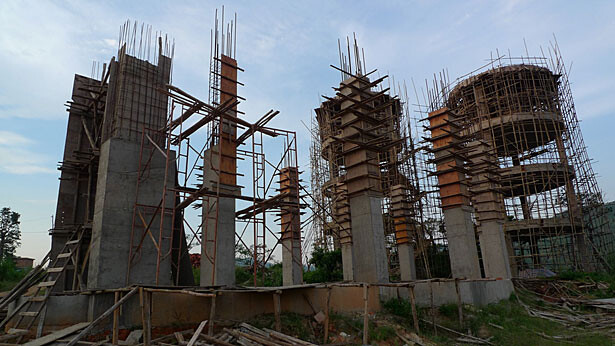

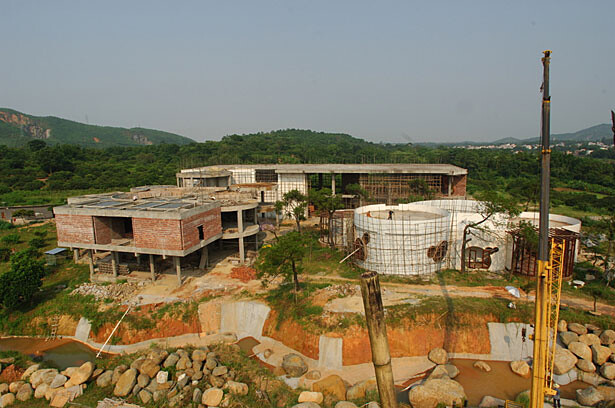

The ongoing conundrum around art’s autonomy—the degree to which art should be responsible to itself alone or to its own particular context and society—is a global issue left largely unresolved. As the world faces a shrinking global economy and the collapse of world financial markets, questions surrounding art’s sovereignty have become all the more pressing. We are all well aware of the ineffectiveness of art criticism in the face of the market, and of the superficialities that have accompanied the art world’s recent bout of lavish overspending and self-aggrandizement.1 But statements that demonize the market or advocate a turn towards sobriety, a “return to substance,” or going back to “art making as it should be,” not only suggest an air of non-complicity, but imply that there is some clear consensus on what it is we should be returning to. By now we are well aware that art has never only been about the market or business-end strategies. The presence of commerce is not anathema to creativity, nor does its absence immediately restore art to a state of purity and innocence. Indeed, the insistence that art production should remain totally free from the market runs dangerously close to one that confines those same aesthetic practices to a space of meaningless insignificance, independent of the social and political conditions that inform and ensure its own very existence.
Rather than look to the market as culprit, we might turn instead to factors that sustain rather than misappropriate artistic production. If we recognize the art market as a subset of concerns contained within a larger entity we know as the art world, then what can be said of the concerns of the art world itself? In order to meet the demands of the market, contemporary art in China has witnessed an unprecedented ramping up of production, and this tendency has threatened outlets for critical reflection and thinking, which in turn thwarts long-term sustainability. Moreover, if the imported aesthetics that inform contemporary Chinese art—installation art, video, and new media—on the one hand trigger suspicion in official institutions and academies raised on a diet of traditional painting and socialist realism, they provide on the other hand a much-needed image of progress and modernization to cover for the government’s totalitarian attitudes. Assessing art’s relationship to autonomy, sovereignty, and independence in the midst of China’s pronounced lack of autonomy in other spheres of life—namely, certain political and social freedoms and values we associate with civil society—becomes entangled not only in social and political concerns, but in increasingly present economic ones. On the surface it would appear that support for contemporary art in China has reached new heights, proven by the influx of art fairs, exhibitions in state-run institutions, and even new forms of government funding.2 But the spirit that underlies these ventures remains solidly aimed at capital gain, market interests, and the business end of art production, with little, if any evidence of support for activities outside this sphere. Whatever subversive tendencies that might remain from earlier periods is quietly tolerated, but more often commercially packaged or even neutralized by the government’s apparently open stance on contemporary art—a position only leveraged by certain individuals when it is deemed convenient (read profitable) or when it follows the prevailing political wind.
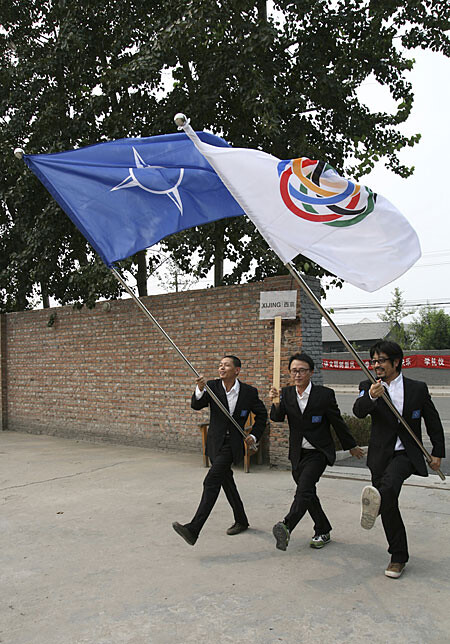

In his essay “The Politics of Installation,” published in this journal, Boris Groys reminds us that although artworks cannot escape their commodity status, they are also not expressly made for buyers and collectors; in other words, the multitude of art biennials, art fairs, and major blockbuster exhibitions has generated an “art public” in which the typical viewer is someone who rarely views the work as a commodity. For Groys, this is evidence that the art system is “on its way to becoming part of the very mass culture that it has for so long sought to observe and analyze from a distance.”3 Such an assessment may hold true for the bulk of the Western art world, but carries less weight in China or in many non-Western regions where contemporary art is still far from being a constitutive element of mass culture. Despite growing numbers of visitors to museums and arts districts in China, contemporary art remains mostly unrecognized by mainstream culture, only haltingly accepted into government-run institutions, absent from the average university art department, and virtually unknown to the average citizen. These truths are often forgotten, especially when one’s time is spent sealed within the gallery-filled espresso culture of the urban contemporary art world. However, there is a sense that this is all about to change, and this makes it all the more important to pay attention to how the groundwork is laid for creative and aesthetic practices that operate apart from, away from, or in resistance to the dominant spheres of commercialism surrounding them. The phenomenon of self-contained “art zones” such as Beijing’s 798 Art Zone are symptomatic of both a desire to segregate art from regular life and an effort to enhance its marketability by referencing its own legacy of success. In the absence of any counterpoint with which to understand this activity, contemporary art continues to be treated explicitly as a form of entertainment, a photo backdrop, or a moneymaking scheme for the burgeoning middle and upper classes. Media attention, private sponsorship, corporate ventures, and personal museums do little to counteract a growing perception that equates contemporary art with investment and market value.
The most enduring dilemma lies in the government’s own directives, which consciously limit art’s interactions with the rest of society. Lumped together into the amorphous designation of “creative industries” and isolated within “creative industry zones,” contemporary art has found itself walled off in places that both contain art and impose a sense of hermeticism. The rapid territorial expansion of contemporary art in Beijing in particular has not only stimulated studio-bound, market-oriented artistic practices, but has further limited site-specific practices to being responses to physical sites at the expense of social or political ones. This radicalization of space serves as a constant reminder of the contested nature of public space in China, and of a lurking authoritarian presence that seeks to control artistic as well as personal participation in the creation of everyday culture.
Distinguishing art from the rest of social life serves the interests of certain groups more than others. Keeping art at a safe distance from (or above) meaningful political engagement and in limited contact with society perpetuates its dependence on status quo economic conditions and social structures, no matter how radical its aesthetics might appear. While the Western appetite for “resistance” has a tendency to cast all art production in China as oppositional or “anti-regime,” this is rarely the case. It may be true that in the absence of meaningful civil society, political society encompasses everything, but by the same token this stimulates an utter indifference with regard to politics itself. Contemporary art in China is plagued by the absence of politics and worse, by the banalization of it. What we need are models that do more than critique the commercial atmosphere surrounding art (while operating from a position of safety)—models that engage meaningfully with the social determinants of production that shape and form art in the first place, asking not what is made, but who makes it, for whom, and under what conditions.4
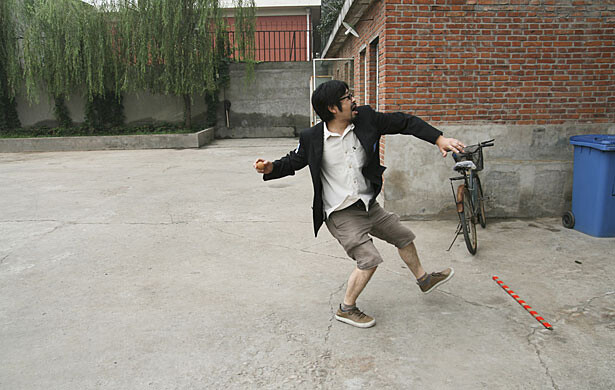

Contemporary art throughout China today suffers from being cut off from both the traditions of the past and the life of the present. Attempting to untangle the knot of aesthetic autonomy in this context only magnifies art’s two perceived dead-ends: autonomous irrelevance or engaged complicity.5 The model of “engaged autonomy” that Charles Esche proposes is thus an intriguing one, suggesting a way to think of autonomy not as something that is invested in the object itself but rather as an action or a way of working.6 It advocates not only an active and participatory attitude, but replaces traditional top-down methods of assigning value and worth with more homespun measures of self-declared legitimacy and collective gain.
Efforts to detach contemporary art from its enclaves have already begun. Art collectives, alternative art spaces, deterritorialized social and relational practices all fit within this schema and present possible critical models for how we understand and witness the ways in which art can exert its own energy upon a given environment or social context, rather than simply emerge as its byproduct. I myself have helped initiate one such endeavor in Beijing called the Arrow Factory—a modestly sized art space where artistic production comes up against the social realities of its own immediate environment. Below I highlight two further art projects which embody possible strategies for an “engaged autonomy” that demonstrates a desire not only to create something that lies beyond the boundaries of the art world, but also to reach new, unprepared audiences.
The work of the Xijing Men is rooted in everyday life and addresses the concerns of average individuals while simultaneously embracing and shattering nationalist frameworks by collaborating across cultural and linguistic borders. Their 2008 Xijing Olympics project has received wide international acclaim, due in part to its availability on websites such as YouTube. Formed by Chinese artist Chen Shaoxiong, Japanese artist Tsuyoshi Ozawa, and Korean artist Gimhongsok on the premise that there exists a northern capital (Beijing), a southern capital (Nanjing), and an eastern capital (Tokyo), but no western capital as of yet, The Xijing Men have taken it upon themselves to explore the option of making one. Collectively hailing from the fictional place of Xijing, their fixed attitudes towards nationhood and cultural or regional identities are overshadowed by values of plurality, multiplicity, and open-ended experimentation from the very start. Collaboration between these three artists from three different Asian countries conjures complicated notions of Asian-ness while offering a discourse centered less on the homogenizing forces of globalization than on the celebration of difference. One key to understanding the Xijing Men can be found in their method of communication. Without a common verbal language, the artists rely instead upon a mixture of broken English, physical gestures, hand-drawn sketches, and occasional handwriting (Chinese, Japanese, and Koreans all share an understanding of Chinese characters) to convey their ideas to one another. Even though they hail from different cultural background, the equalizing factor is language, with each from the very start working outside his ‘zone of comfort’ linguistically.
Staged in August 2008 during the official Beijing Olympic Games, Xijing Olympics presented a humorous yet provocative take on the unabashedly spectacular Olympics mania that gripped China last summer. In the outskirts of Beijing, the artist group carried out their own version, casting themselves as “athletes” and their family and friends as “audience.” Drawing from everyday objects and experiences—kicking watermelons instead of soccer balls, marathon napping, giving massages with boxing gloves, and other absurdities such as a three-way table tennis match using shoes as paddles—their version mocked the seriousness and solemnity with which the Chinese government (and by association, the Chinese public) treated the glitzy theatrics of the real Beijing Games. The Xijing Men replaced themes of winning, success, and public entertainment with modesty, simplicity, and failure. If the Games themselves constituted the supreme performance of Chinese national pride under the auspices of international diplomacy (never mind the subtext of China’s own eager aspirations to secure its position among the global superpowers), then the Xijing Olympics represented a caricature of these attitudes in which humor, playfulness, and aimlessness are injected into the highly scripted and ceremonial tone of the official games. Their antics worked to present a kind of informal locality to offset the trope of national spectacle, and in the process identified more directly with the concerns of average citizens, whose struggles to negotiate the massive transformations enveloping their way of life go largely unnoticed. The low-tech theatrics of the Xijing Olympics reflected a form of practice that is refreshingly human-scaled and attuned to the proximity of individuals rather than traditional groupings conditioned by notions of the “mass” and the “people.”
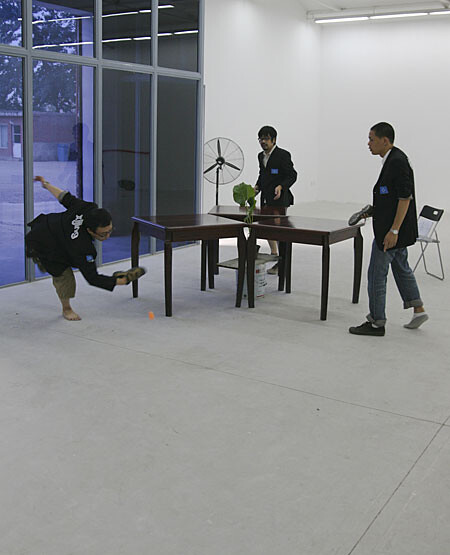

Continuing the logic of game-playing, artist Zheng Guogu’s ambitious Age of Empire (2001–) is part land art, part playground, and part social experiment. Inspired by the computer game series Age of Empires, in which players control historical world civilizations, Zheng is gradually transforming an agricultural area on the outskirts of Yangjiang city into a real-world replica of the game’s virtual community. It began in 2000, when a friend gave him a tip on some cheap land in the outskirts of the city, after which he soon bought up 5000 sq m. By 2005 he had acquired more neighboring plots to arrive at 20,000 sq m, which has today grown to 40,000 sq m (approximately 10 acres) and counting. Zheng has since replaced the existing landscape with an entirely new one that includes hills and mountains and a small village area, all surrounded by a stone wall.
Age of Empire is a project that does not concern itself with making a finished artwork—to date not a single building has been completed—rather, it functions as an exercise in turning the fictional into reality, or, more accurately, as an experiment in the social process of making itself. For many contemporary artists in China, art is viewed as a profession—treated as an occupation rather than a way of life. The prescribed categories of artist, calligrapher, or architect are all designations that Zheng disavows and slowly works to dissolve. Although ostensibly meant to house an artist studio, a small museum, and living and entertainment quarters, the real achievement of Age of Empire lies in its integration of life and art. As Zheng recreates his made-up game on real land, he faces real-world concerns about securing money, building rights, and the location of materials. Thus the sleepy coastal town of Yangjiang—small by Chinese standards, with a population of some 2 million—comes to stand as a microcosm for survival: underneath lurks a contested ground, a community full of underground systems and partial struggles that inform everyday life, and, by association, Zheng’s diverse practice.
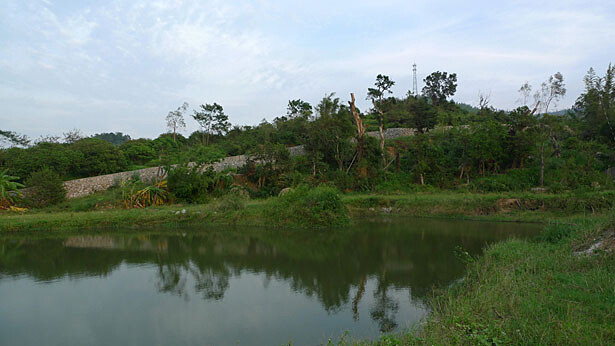

Though his work deals with familiar themes of consumerism and tropes of transformation, he is also content to show us that which is constant and unchanging—a glimpse into the steady pace of life in his hometown of Yangjiang in the southern province of Guangdong. As Zheng knowingly acquired his land through illegal means (though he exchanged money and signed agreements with all the farmers he bought from, this land was legally not theirs to sell, as all land in China belongs to the state), which essentially means that local building officials can give him constant headaches for building on it and potentially obstruct the whole enterprise. Thus Zheng’s daily activities have quickly become consumed by wining, dining, and bribing the local officials in efforts to curry favor, maintain good relations, and negotiate with the proper channels. In making Age of Empire, he cooperates with the system in order to transcend it, becoming complicit yet independent at the same time. As Zheng says, “I live here and drink with my friends all day. I can let them know the traces of an artist. I can talk about art to a fishmonger today, to a man eating abalone tomorrow. Or I can talk to the boss of a snack bar.” His family, friends, objects, experiences, social interactions, and recreational activities—nearly everything in his life and surroundings—embed themselves and leave traces in his art. From this stable position, a certain sense of freedom enables Zheng to take risks that transcend the usual boundaries of art. In this sense, Zheng Guogu presents us with a sort of hypothesis: if real life can become art once it enters the world of art—by means of galleries, museums, and exhibitions—then what are the ways in which art can be returned to become a part of one’s everyday existence?
Projects like Age of Empire and the work of the Xijing Men will continue to operate spontaneously with no fixed timeframe, set limits, or defined outcome. Zheng has calculated a means of living his art through his daily actions, calling into question our awareness of our own practices as artists, critics, curators, historians, and audience members—practices that define the boundaries of the art world in the first place. Like Zheng talking to the man eating abalone, or to the fishmonger, we are witnessing the art world’s traditional borders becoming indivisible from those of the social order it is inclined to merely portray. As Zheng says, “The artist is around them, and he does leave a trace. It’s a gradual process to see the effect of that.”7 The question becomes whether this trace is deemed immanent in the utopian processes we attribute to art.
For more on the state of contemporary art criticism in China, see my text “Critical Horizons: On Art Criticism in China,” Diaaalogues, Asia Art Archive Online Newsletter, (December 2008), →.
By “government funding” I refer to the Beijing Culture and Development Fund’s establishment of the Art Beijing Fund, a fund of 5 million Chinese yuan (roughly 732,000 US dollars) which was recently put to use sponsoring galleries to participate in the Art Beijing art fair.
Boris Groys, “Politics of Installation,” e-flux journal, no. 2 (January 2009), →.
For more on issues of production, see my book In Production Mode: Contemporary Art in China, [Hong Kong: Timezone 8 Books, (in cooperation with CCAA), 2008].
Charles Esche, Foreword, Afterall Journal, no. 11 (2006).
Ibid.
Zheng Guogu, interview by Hu Fang, Jumping out of Three Dimensions, Staying Outside Five Elements. Guangzhou: Vitamin Creative Space, 2007. (unpaginated)

